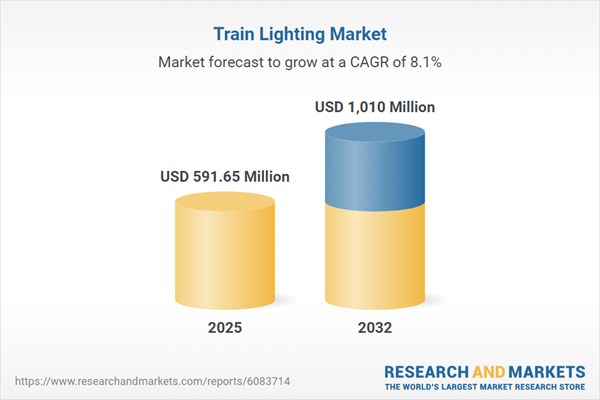Speak directly to the analyst to clarify any post sales queries you may have.
The train lighting market is experiencing a period of rapid transformation, driven by innovation, environmental mandates, and evolving end-user expectations. Advances in digital connectivity and energy-efficient solutions are fundamentally reshaping the way rail lighting supports safety, operational efficiency, and passenger experience.
Market Snapshot: Train Lighting Market Size and Growth
The train lighting market grew from USD 546.58 million in 2024 to USD 591.65 million in 2025 and is projected to reach USD 1.01 billion by 2032, registering a CAGR of 8.06%. This robust upward trajectory reflects consistent investment in energy-efficient technology, evolving safety regulations, and the integration of digital capabilities. Market participants are prioritizing adaptive systems and embracing both retrofit and greenfield opportunities across global rail networks.
Scope & Segmentation of the Train Lighting Market
- Technology: Fluorescent, Halogen, Incandescent, LED (including Adaptive Lighting, IoT Enabled, Sensor Based)
- Application: Exteriors (Headlamps, Marker Lights, Signal Lights, Tail Lights), Interiors (Corridors, Driver Cabin, Passenger Compartment, Vestibules)
- End User: Aftermarket, OEM
- Train Type: Freight Trains, High Speed, Metro, Passenger Trains
- Installation Type: Recessed, Surface Mount, Track Lighting
- Geographical Regions: Americas (United States, Canada, Mexico, Brazil, Argentina, Chile, Colombia, Peru), Europe/Middle East/Africa (United Kingdom, Germany, France, Russia, Italy, Spain, Netherlands, Sweden, Poland, Switzerland, United Arab Emirates, Saudi Arabia, Qatar, Turkey, Israel, South Africa, Nigeria, Egypt, Kenya), Asia-Pacific (China, India, Japan, Australia, South Korea, Indonesia, Thailand, Malaysia, Singapore, Taiwan)
- Key Companies: Signify N.V., OSRAM GmbH, Wabtec Corporation, Siemens Mobility GmbH, ABB Ltd., Knorr-Bremse AG, HELLA GmbH & Co. KGaA, Schréder S.A., Luminator Technology Group, Inc., ZKW Lichtsysteme GmbH
Key Takeaways for Decision-Makers
- Technological adoption is shifting from conventional lamps to solid-state lighting, driven by demands for longer life, energy reduction, and modularity.
- The integration of IoT, adaptive beam control, and sensor-based dimming is enabling dynamic lighting environments responsive to occupancy and track conditions.
- End users are increasingly valuing lifecycle cost, with preference for solutions offering remote monitoring, reduced maintenance, and ease of retrofitting.
- Regional regulations emphasizing glare reduction and light pollution are influencing both product design and deployment strategy across continents.
- Collaboration between lighting suppliers and rail OEMs is leading to customized systems, standardization efforts, and new business models that span hardware and digital services.
- Lighting is playing a larger role in enhancing the overall passenger journey, focusing on ambience, safety, and operational transparency.
Tariff Impact and Supply Chain Adjustments
Recent United States tariff policies have catalyzed industry-wide changes in sourcing strategies and cost structures. Manufacturers are diversifying supplier bases, bolstering local production, and reinforcing supply chain resilience. Strategic partnerships and long-term contracts are playing a key role in stabilizing pricing and managing lead times within both OEM and aftermarket channels.
Research Methodology & Data Integrity
This report is underpinned by primary interviews with industry leaders and secondary research involving technical white papers, regulatory documents, and financial disclosures. Triangulation and expert review ensure accuracy and credibility in segment insights, policy impacts, and competitive dynamics.
Why This Report Matters for the Train Lighting Market
- Provides senior executives and strategy teams with actionable intelligence to inform investments and roadmap decisions in a rapidly changing sector.
- Supports procurement, engineering, and regulatory teams by clarifying shifts in technology, supplier strategies, and compliance frameworks.
- Helps identify opportunities for differentiation and partnership along the value chain, from smart retrofits to integrated digital platforms.
Conclusion
The train lighting market continues to evolve, shaped by innovation, regulatory pressures, and shifting end-user priorities. Strategic agility, cross-value chain partnerships, and technology-driven differentiation will be central to succeeding in this dynamic sector.
Table of Contents
3. Executive Summary
4. Market Overview
7. Cumulative Impact of Artificial Intelligence 2025
Companies Mentioned
The companies profiled in this Train Lighting market report include:- Signify N.V.
- OSRAM GmbH
- Wabtec Corporation
- Siemens Mobility GmbH
- ABB Ltd.
- Knorr-Bremse AG
- HELLA GmbH & Co. KGaA
- Schréder S.A.
- Luminator Technology Group, Inc.
- ZKW Lichtsysteme GmbH
Table Information
| Report Attribute | Details |
|---|---|
| No. of Pages | 183 |
| Published | October 2025 |
| Forecast Period | 2025 - 2032 |
| Estimated Market Value ( USD | $ 591.65 Million |
| Forecasted Market Value ( USD | $ 1010 Million |
| Compound Annual Growth Rate | 8.0% |
| Regions Covered | Global |
| No. of Companies Mentioned | 11 |









